Trust in Digital Publishing 2021
The general public has a complicated relationship with news sites.
On the one hand, news organizations are the ones informing the general public about what’s going on in the world — and people trust them to do so. Yet because there’s such high trust, there’s also high expectations for organizations to present news accurately and objectively. Any departure from those principles breaks reader trust.
Not only are organizations who deliberately do this at risk of losing readership, but organizations who continue to allow sloppy or unprofessional journalistic practices are at risk of losing readership as well. News organizations are made or broken based on the trust they have with their followers — and too often they don’t have a second chance to get it right.
We wanted to learn more about how consumers of the news trusted the organizations they go to to find out about the world, as well as how trusting are they of the sites they follow and what the threshold is for a news organization to break that trust. News organizations need to know if they’re doing all they can to keep readership, and what they can do if they let their readership down.
Methodology
On April 15, 2021, we surveyed 1000 Europeans to learn more about how they trust the news they read. The top five countries from which our respondents came are: Italy (15.5%), Poland (13.3%), Spain (11.9%), Romania (10%), and France (7.6%). 18 other countries were also represented.
Most respondents fell between ages 18 and 44: 25.3% between 18 and 24, 28.4% between 25 and 34, and 27.6% between 35 and 44. 17.3% were over age 44, and 1.4% were under the age of 18.

Of those we surveyed, 54.8% are male and 45.2% are female.
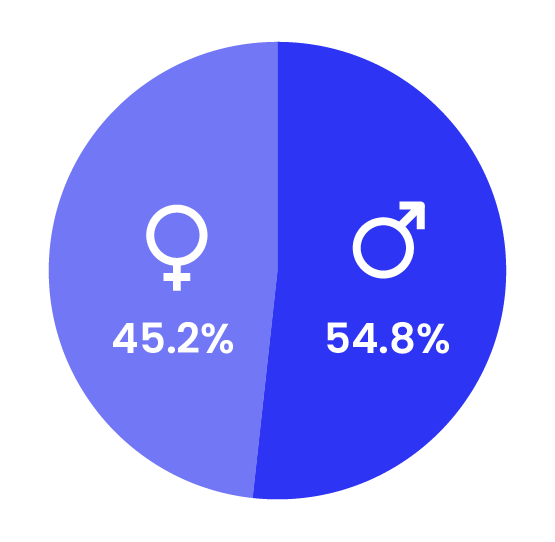
Key Findings
46% will pay for news that’s accurate. Respondents said they’d be willing to pay for a news site subscription if they know the site publishes news that is accurate, factual, and objective.
28% are changing where they get their news from more today than ever. Additionally, 42% have stopped going to news sites they had gone to previously, meaning news site loyalty needs to be earned and maintained.
51% abandoned a news source because of one inaccurate article. Our respondents value accurate and fact-checked news, and half stopped following a site because of one inaccurate article — meaning the stakes are high for keeping readership.
61% want better fact-checking and a focus on accuracy. When it comes to improving trust amongst readers, our respondents want organizations to focus on getting the story correct before rushing it to print.
35% don’t think news organizations have their best interests in mind. Respondents were also neutral about trusting or distrusting news sites, and didn’t see news sites as being highly transparent.
Part 1: News Consumption
Understanding our respondents starts with understanding their news consumption habits — which can also tell us a lot about how they value news and reporting as well. In this first section, we wanted to better understand where people go for their news, if they’re relying on one or multiple sources of news, and if they’re paying for access or simply relying on free sources.
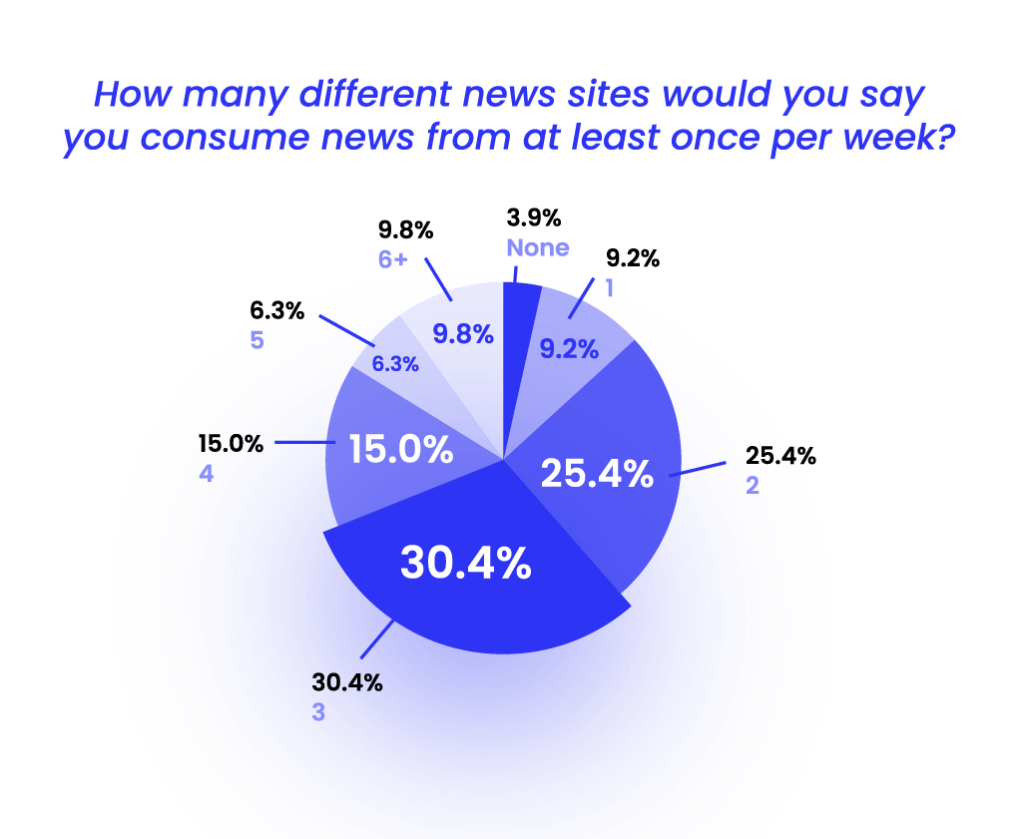
Most are checking two to four news sites per week
Are our respondents relying on just one site for their news, or checking a variety of them to get a fuller picture of the various news cycles? The majority of our respondents (30.4%) are getting their news from three news sites per week, a good number to ensure fact-checking one source against two others. The next largest segment (25.4%) is getting news from two news sites per week, and the third largest segment (15%) is going to four news sites per week. 6.3% are going to five news sites, and 9.8% are going to six or more. Only 9.2% rely on one site, and 3.9% report checking none.
They visit online news sites directly to get their news
The most common way our respondents consume online news (37.2%) is by visiting news websites directly, either through bookmarked links, through newsletters, or through the company’s apps. They have news sites that they regularly follow and trust, and go to those first, instead of picking up news from unfamiliar sources in a news feed or search engine.
Other ways they find news include:
- 15.7% follow news companies on social media
- 14.1% find news by searching Google
- 12.5% get their news from friends sharing links on social media
- 7.9% use a news app on their phone
- 7.1% get their news from emails from the news company
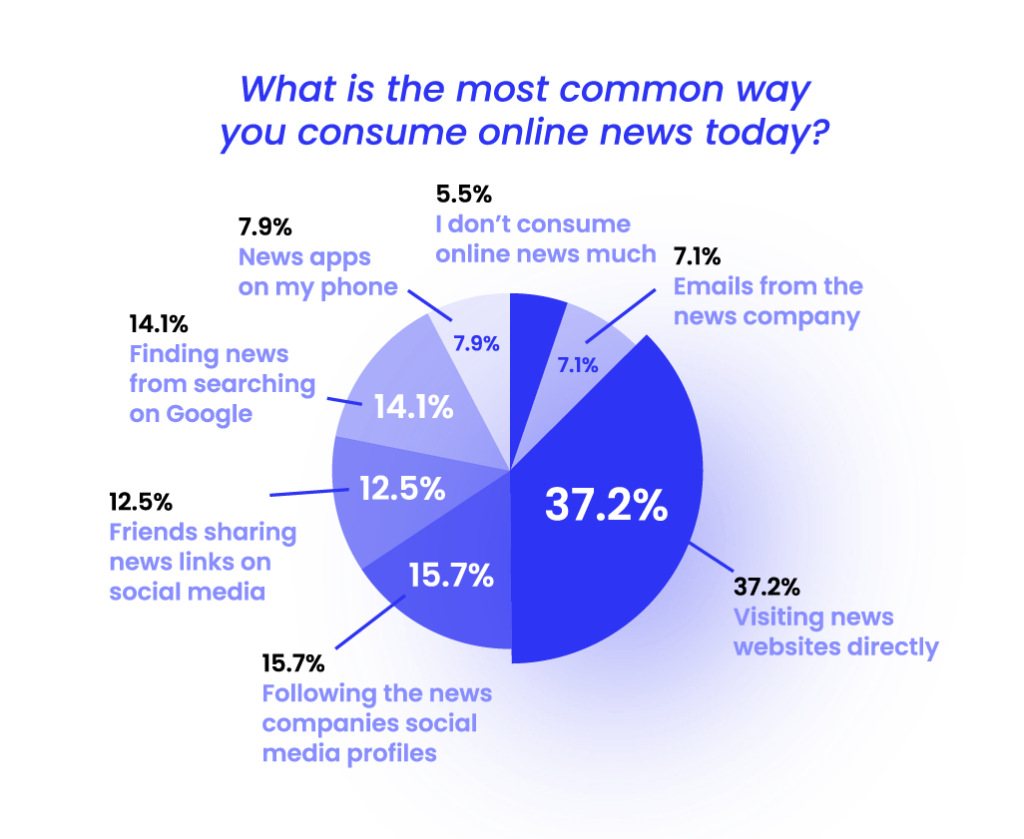
Only 25% are paying to access news
Knowing the different ways our respondents consume news, we next wanted to know if they paid for access, or relied on free sources. Only a quarter of our respondents (25.4%) say they paid for a news subscription, while 74.6% rely on freely accessible news.
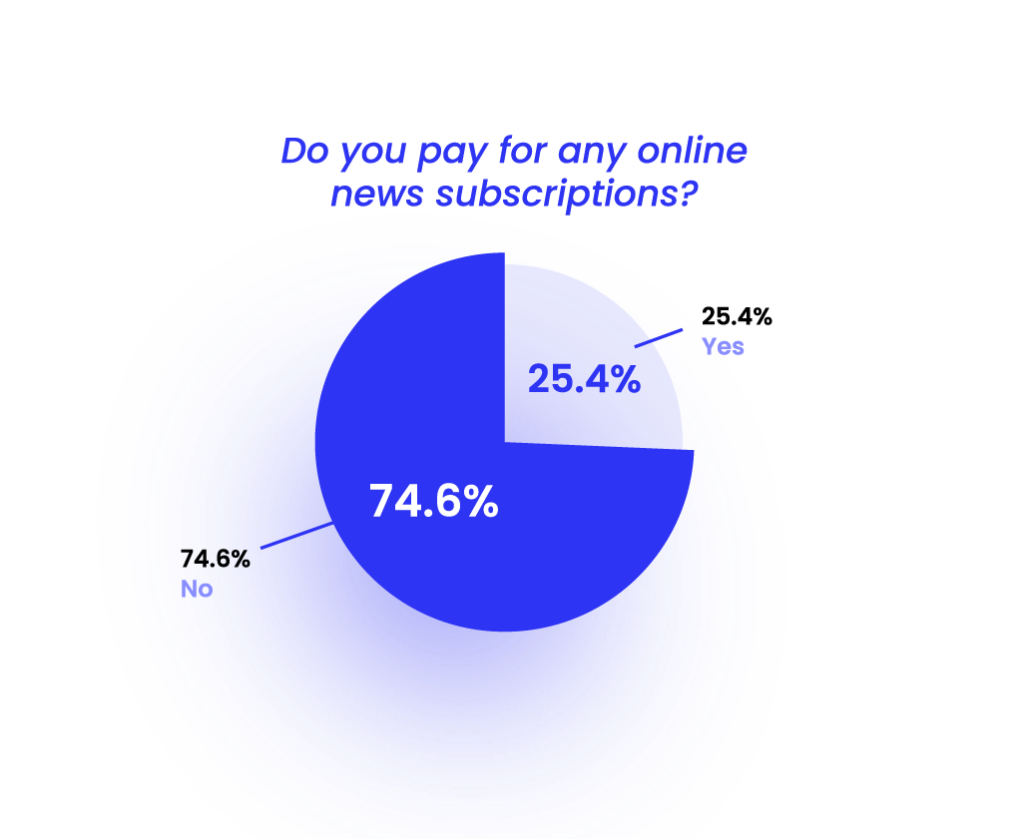
They spend between 1 and 10 euros per month on a subscription
For those who do pay for a news subscription, the majority (36.2%) are spending between 1 and 10 euros for it, with an additional 31.5% spending between 10 and 20 euros for their subscription. 16.9% spend between 20 and 30 euros for their news each month, and 12.9% are spending 30 euros or more.
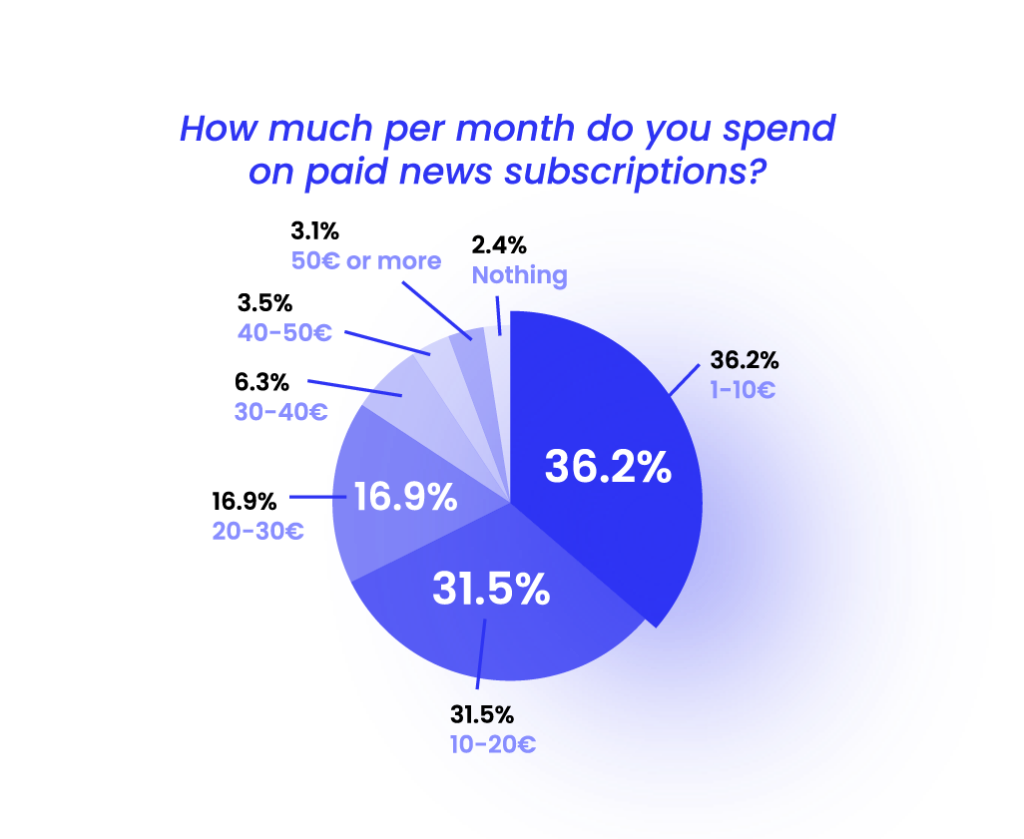
Most will continue to spend the same amount on news in the next year
In terms of anticipating news consumption and behaviors over the next year, how do our respondents expect their behavior to change when it comes to paying for news? Over half (53.2%) believe they’ll spend the same amount on news going forward — in other words, they believe they’re getting the right value for what they’re paying for (or not paying for). 20.1% believe that they’re going to spend a little more for news, while 10.9% believe they will stop paying for news altogether.
In total, 24.9% believe they will spend more in the next year — which indicates an audience looking for quality news sites to subscribe to — while 21.9% believe they will pay less.
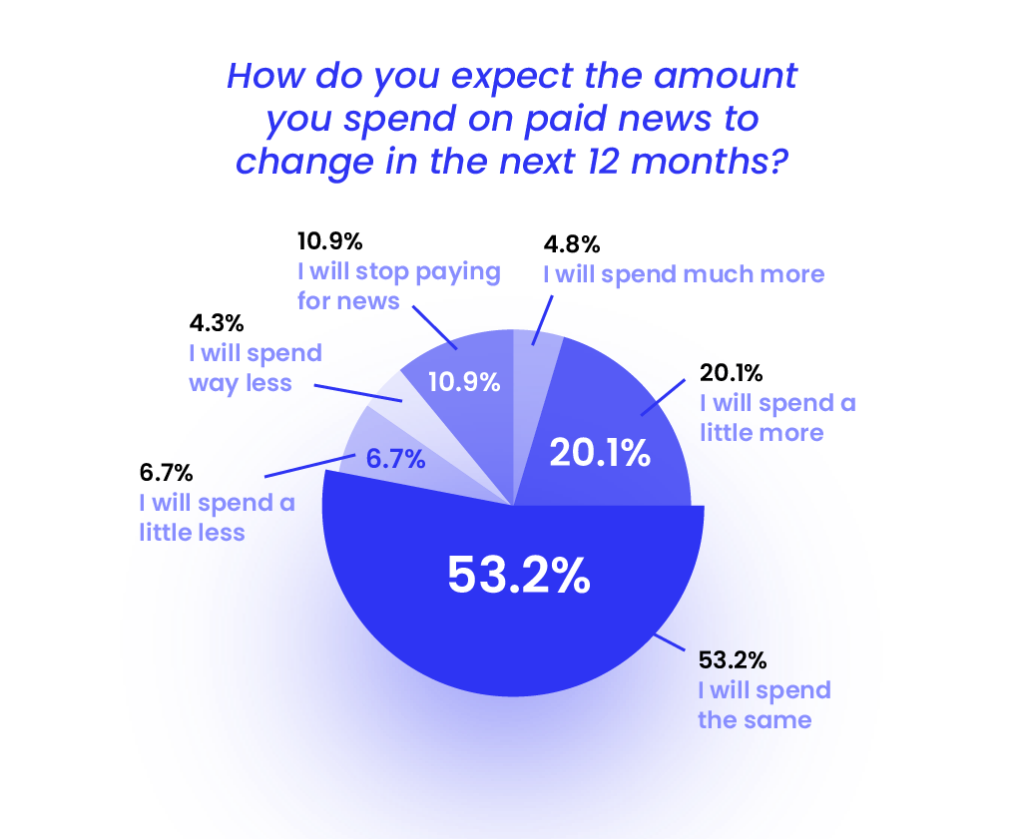
46% are willingness to pay for accurate information
What would get someone to be willing to pay for their news, rather than consume it through free sources? According to our respondents, nearly half (45.6%) would pay for news if they can trust that the news outlet will publish accurate information. 28.8% also replied that they would pay for news if they were getting unique information that they couldn’t get elsewhere. If news sites want to increase subscriptions, or get subscribers to pay more, they need to focus on accurate information and unique offerings.
13.2% replied that they would pay if it were unique information they needed for their job, 7.8% said they would pay to help fund good journalism, and 4.6% would pay to read content from specific journalists that they like.
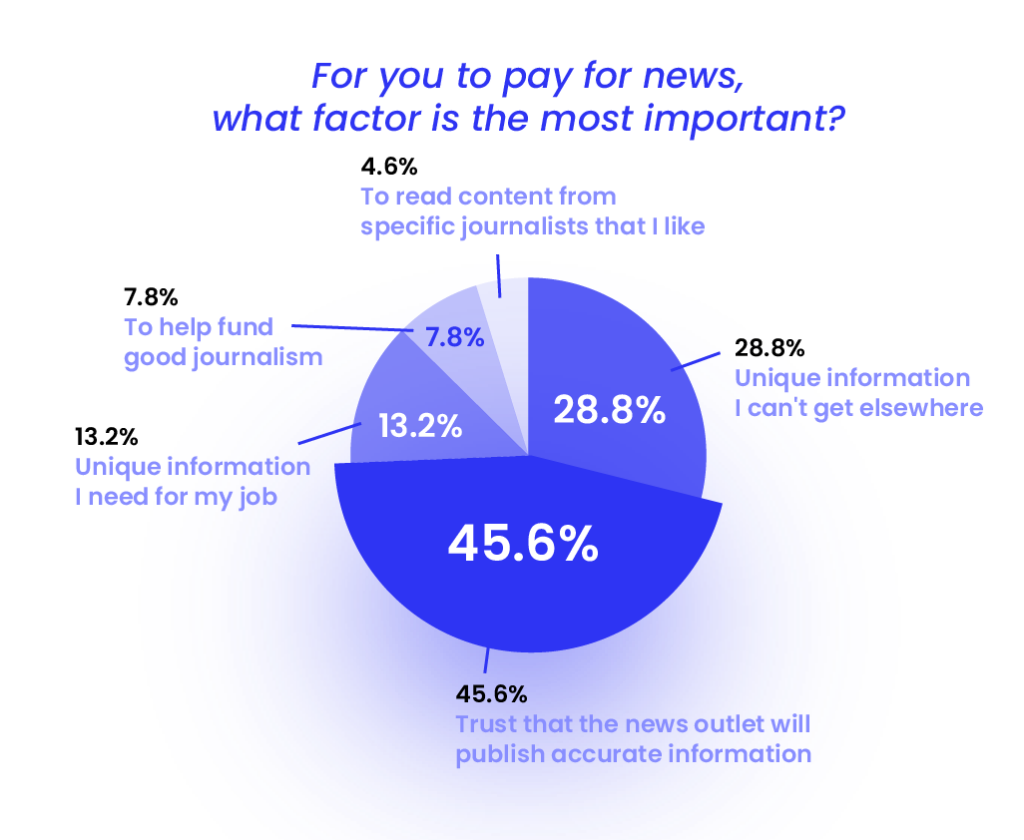
Section Summary
Our respondents are somewhat savvy when it comes to their consumption of news. The majority are checking multiple sites for news — meaning they’re not letting one source create the narrative for them. 37% are visiting their preferred news websites directly to learn more, actively going to seek out the news instead of waiting for it to come to them via social media or word of mouth.
However, three-quarters are still relying on free sources of news, which can be limiting in terms of access to quality content and journalism. However, there is a high willingness to pay for news if they know the news site is publishing accurate information. As we’ll see in our next section, accuracy, fact-checking, and getting news correct is a big factor in whether someone will follow a news site or abandon it completely.
Part 2: Trust in Media
News organizations and journalists should be trustworthy. Readers should be able to know that they’re getting accurate, objective, and legitimate reporting from news sites, and shouldn’t have to worry that they’re reading sloppy journalism or shoddy fact-checking. In this next section we wanted to learn more about the trust our respondents have in the news sources they visit, and their view on transparency and legitimacy.
41% have neither a high or low level of trust in news organizations
First, how much do our respondents trust news organizations? They skewed neutral to trusting: 40.8% replied that they had a neutral level of trust (neither high nor low) for news organizations. Those with a somewhat high (36.5%) level of trust and very high (6.8%) level of trust were 43%. Those with a somewhat low (12.1%) level of trust or very low (3.8%) level of trust were only 15.9%.
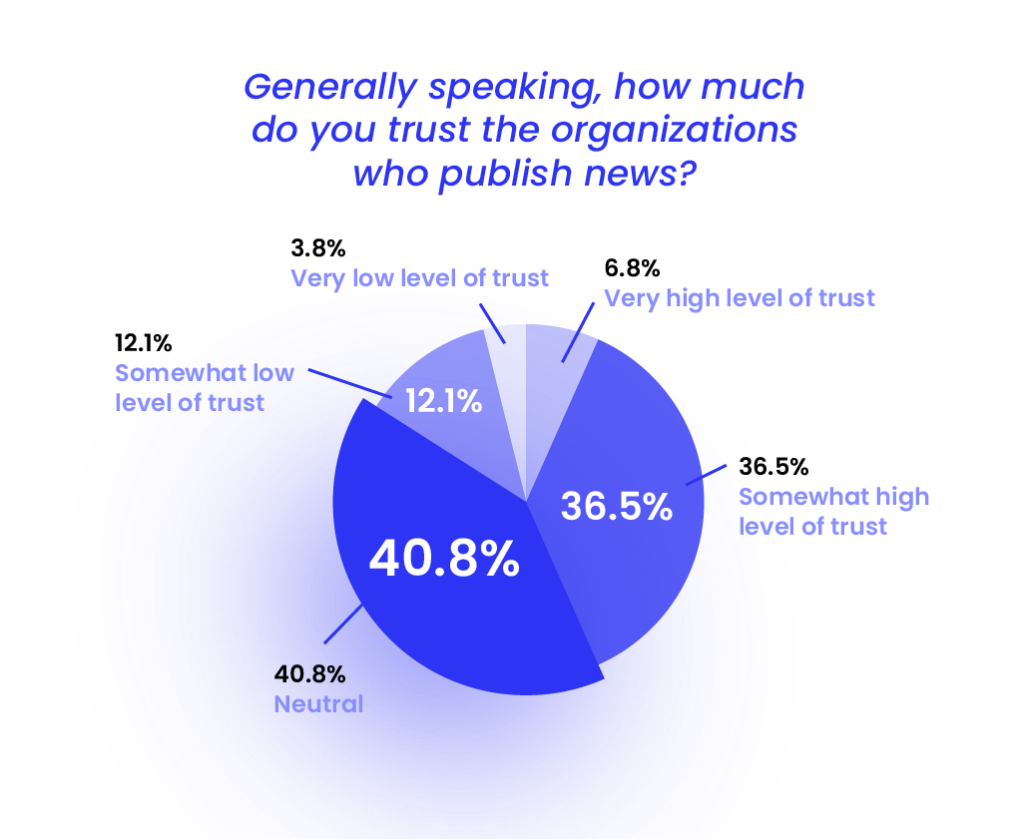
41% have neither a high or low level of trust in journalists
When we asked how much they trust the journalists who write the news, we found nearly similar responses: 41.4% had a neutral view of journalists. 41% had a somewhat high (35.3%) or very high (5.7%) level of trust, and 17.6% had a somewhat low (12.8%) or very low (4.8%) level of trust.
These similar numbers could suggest that our respondents consider organizations and journalists the same, or their reputations as tied together. In other words, we didn’t see more trust in journalists and less in organizations, or vice versa.
37% believe news organizations have neither a high or low level of transparency
When it comes to being open about gathered facts, sourcing, and authorship, how much transparency do our respondents believe news websites and journalists offer to their readers? They were split on their view: 37.2% were neutral, believing that news organizations offered neither a high nor low level of transparency. However, 38.3% believe that news organizations offer a somewhat high (31.8%) or very high level of transparency (6.5%), while 24.5% believe that organizations offer a somewhat low (20.3%) or very low (4.2%) level of transparency.
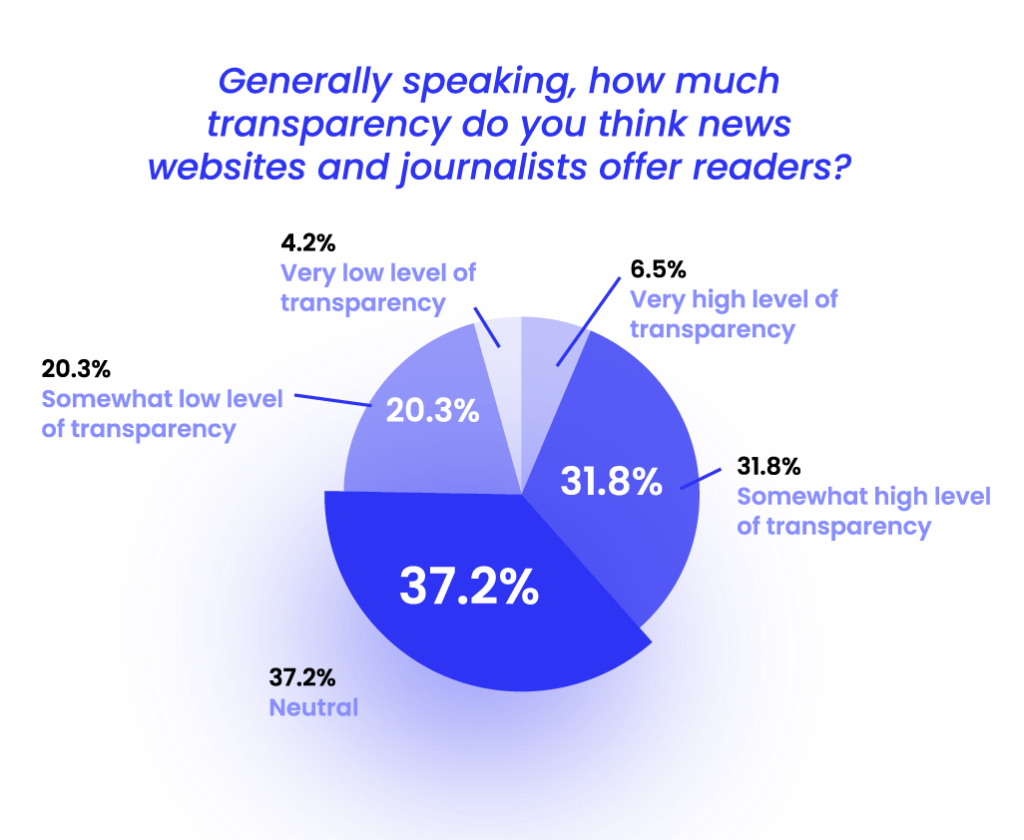
Content and reputation make an article legitimate
What criteria do our respondents use when deeming a news article legitimate? The two biggest criteria were the content of the article itself (27.7%) and the reputation of the organization that published it (25.5%). 19.7% also report that the sources behind the information can help determine its legitimacy.
Additional, but not nearly as detrimental, factors include:
- The reputation of the author that published the article (8.6%)
- Common sense (7.3%)
- The opinion of experts on the subject (4.2%)
- The ability to see how information has changed (3.9%)
- Other news articles that tell a similar story (2.1%)
- The opinion of friends and relatives (1%)
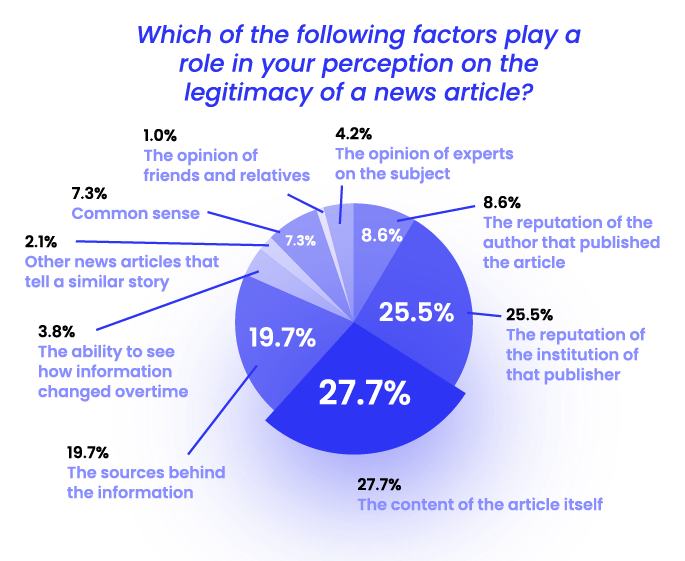
35% don’t believe news sites have their best interests in mind
In terms of trust, we wanted to know if our respondents believed that news outlets have their best interests in mind when creating and distributing news. Over two-thirds of our respondents (65.2%) believe that news organizations do have their best interests in mind, while 34.8% believe they do not.
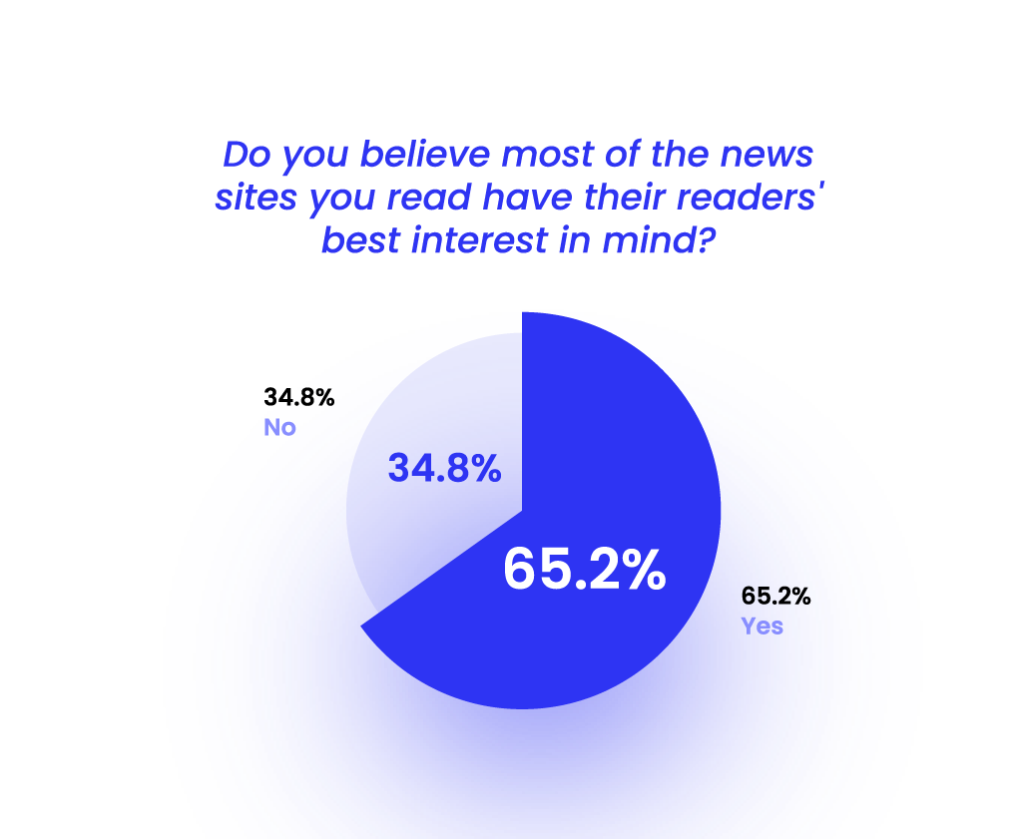
Section Summary
This section gave us a sense of our respondents’ position on trust, which turns out is mostly neutral, meaning that they don’t not trust news organizations and journalists, but they also don’t trust them, either. As we saw here in regards to article legitimacy, and as we’ll see in the next section, there’s almost a sense of “wait and see” — I neither trust nor distrust the institutions, but I’ll base my judgements on the accuracy and content of the articles themselves. However, we did see many of our respondents reply that they do have a somewhat high level of trust in organizations and journalists, so overall, they’re pretty trusting who is creating their news.
While the numbers were similar for our question about transparency, the view of what that means isn’t the same. While trust is subjective, transparency is objective: A news site is either being transparent with its sources, facts, and methods, or not. Here, our respondents remained mostly neutral — and any response that isn’t “high level of transparency” means that news sites are lacking in disclosing their practices.
We see this as well in that two-thirds replied that they believe news sites do have their readers’ best interests in mind. Yet the fact that this wasn’t 100% means there’s still trust work to be done.
Part 3: Impact of Distrust
Good journalism relies on objectively reporting on the facts. That’s what readers expect, but if that commitment isn’t upheld, readers could go elsewhere. In this section, we wanted to dig into behavior related to what our respondents find on news sites. What happens if a site is publishing inaccurate information? What if they start to show a bias? As we found, there’s a lot at stake, and news organizations may not have a second chance to get it right.
28% are changing news sites more often than before
When it comes to staying with their go-to news sites or finding other sites to follow, the majority of our respondents (53.1%) say that they change their news sites about the same as they always do — meaning that there’s nothing recently that made them question their news site choices. 17.1% change their news sites less than ever before.
However, 27.6% are changing the news sites they follow more often today than they have before, either signaling they’re becoming a more aware reader or their previous news site go-tos were no longer providing the content or accuracy they wanted. One response in “Other” explains that due to the lack of facts and information prevalent in news today, they have to check more sites to essentially gather the right information themselves.
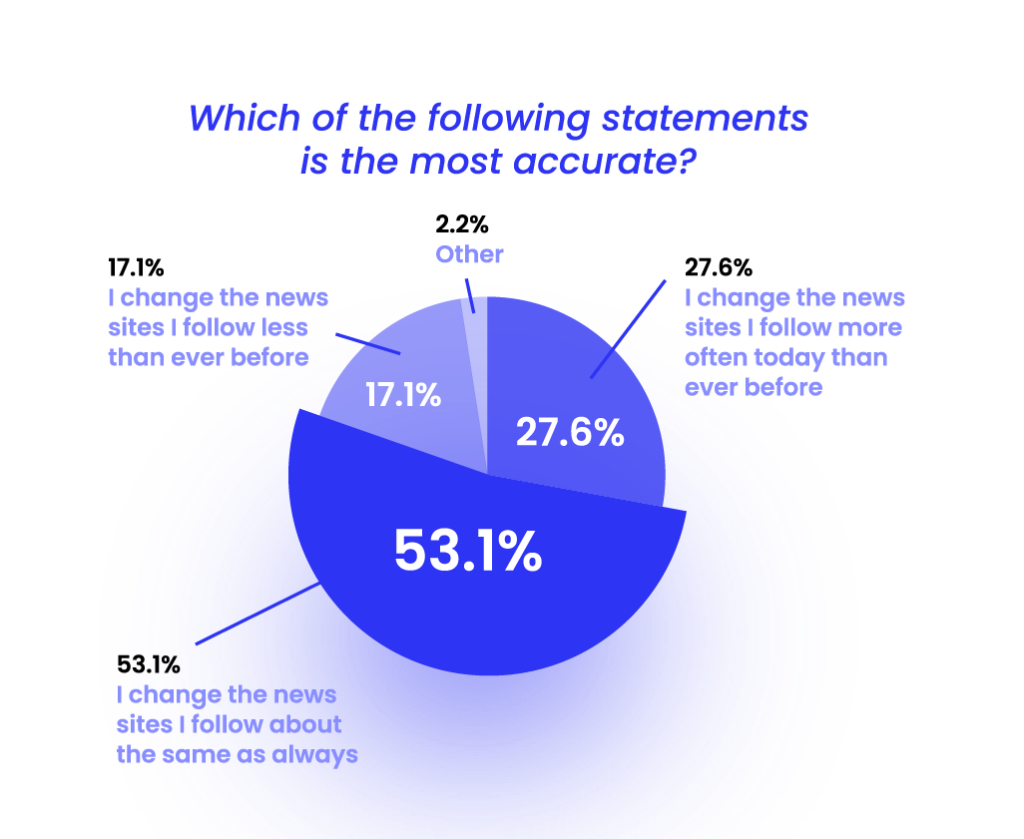
42% have stopped consuming news from an organization they previously followed
Have our respondents stopped consuming news from a site or organization they previously read in the past year? 42.4% say they have turned away from news sites they previously went to — which means loyalty isn’t necessarily long-term — while 57.6% have not.
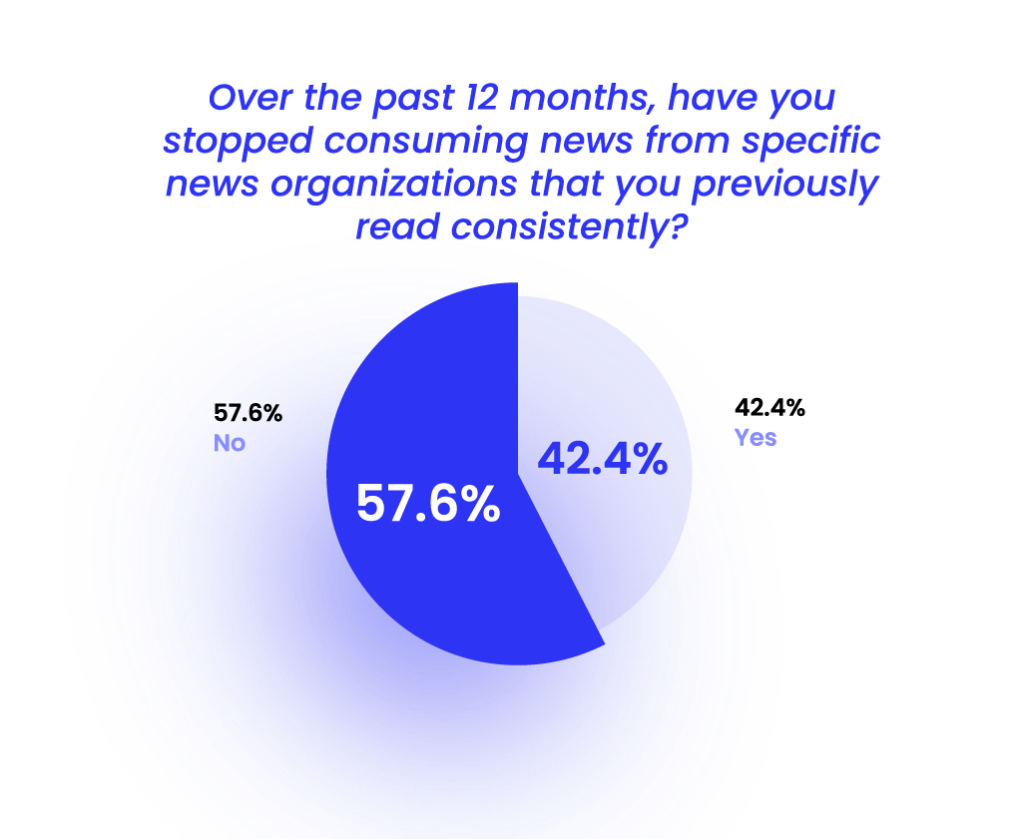
Consistently publishing inaccurate news made readers stop reading
If they have abandoned a news site or organization, the reason most did was because the news site consistently published news with inaccurate information (32.1%). 23.6% did because the news site consistently published news to support an agenda. Or, respondents left a news site because they felt their trust was broken: “I trust you to provide me with accurate, factual, objective news, and you didn’t.”
For 17.9%, they turned away because they found the articles of poor quality. 15.3% left because the site started charging for news. 9.2% left because the advertising was too intrusive.
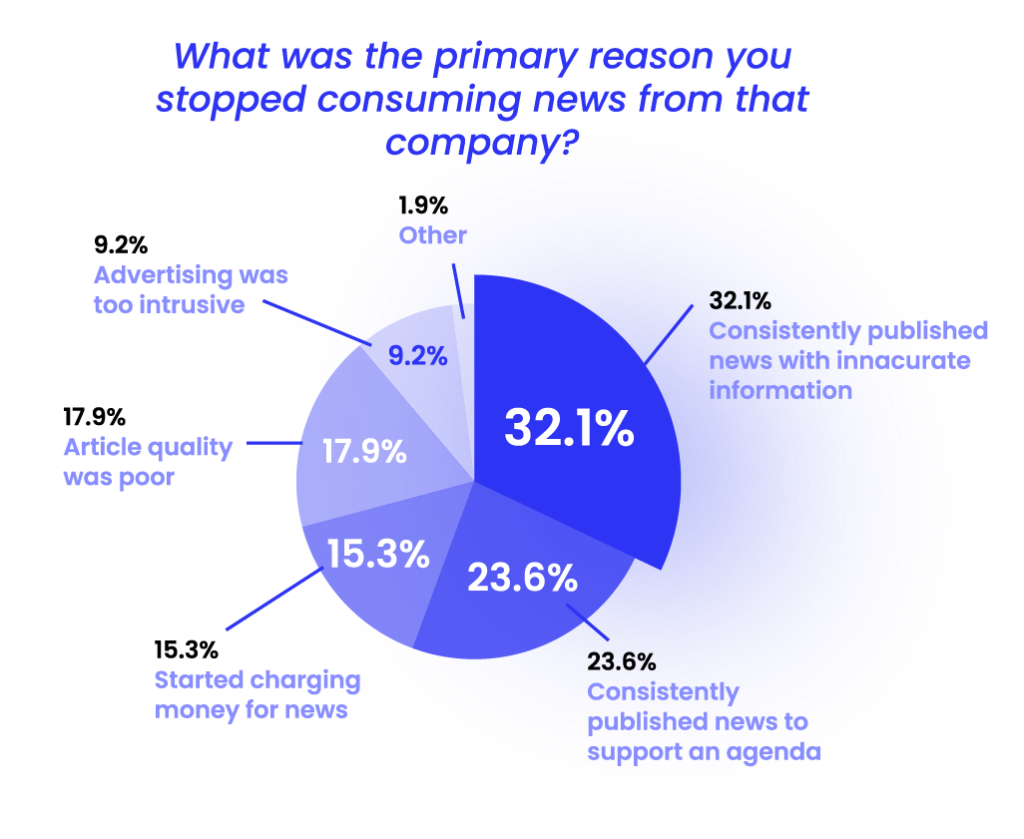
51% stopped following a news source because of one inaccurate article
Knowing some of the reasons why our respondents turn away from news sites, we were curious if they have ever stopped consuming news from a certain organization because the news site published one article they felt was inaccurate. Half of our respondents (51.1%) had indeed stopped going to a news site because of one article. If one incorrect article is enough to break trust, then the stakes are high for news organizations to get it right.
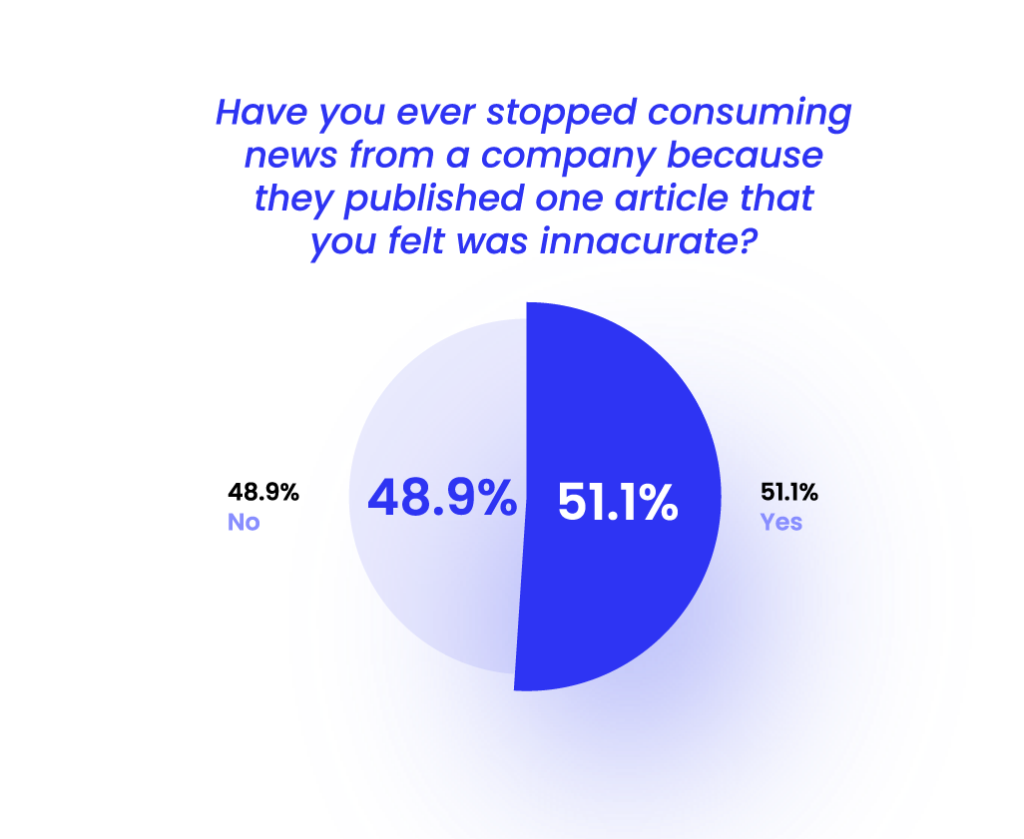
Addressing the inaccurate information could draw readers back
If a news site or organization had lost their readership due to the reasons above, what would be some actions they could take to win that readership back? The majority of our respondents (35.8%) wanted that news organization to demonstrate they had addressed the fact that they published inaccurate information. 33.9% believe that news sites would need to publicly apologize for the mistake in order to win them back as readers. Nearly a quarter (23.1%) replied that there was nothing the organization could do — their trust had already been lost.
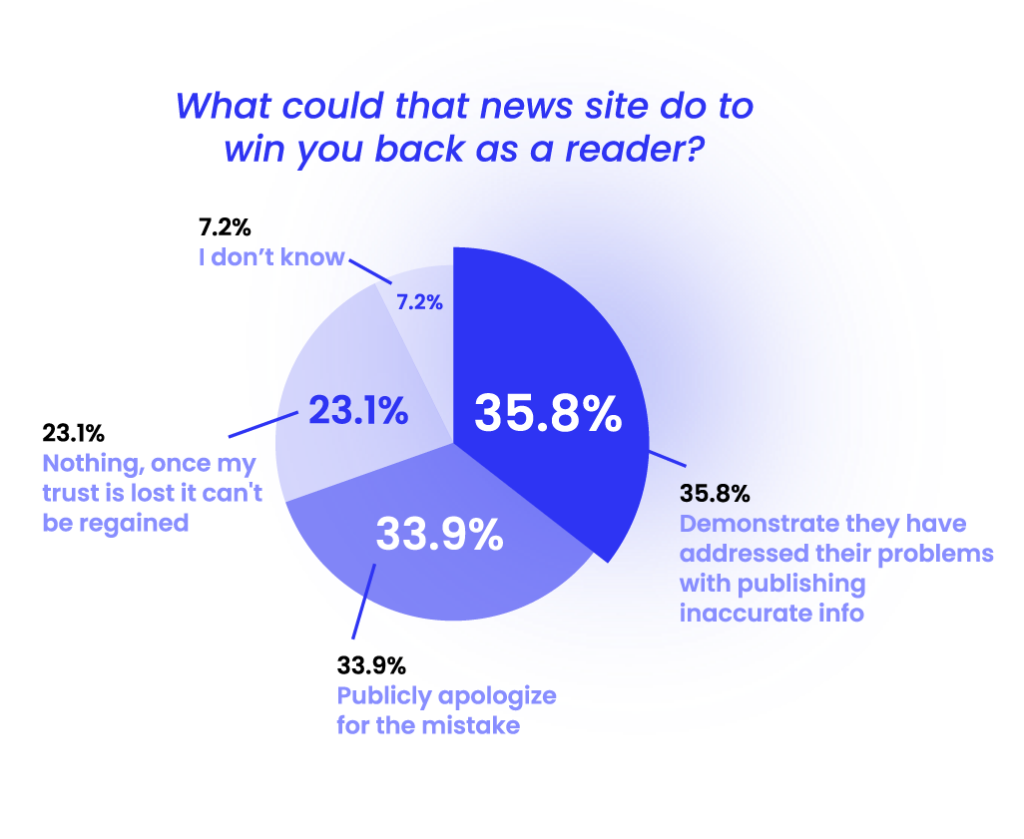
Section Summary
We’re starting to get a fuller picture of the kinds of stakes readers hold news sites to when it comes to providing accurate and objective reporting. 28% are changing their news sites more often than they did in the past, and 42% have turned away from sites they previously followed in the past. They’re doing so because of inaccurate information, biased information, unchecked facts — all the things they don’t expect a professional news organization to do. The expectation of accurate reporting is so high that respondents have abandoned news sites that have published only one inaccurate article — and, if they’re a paid subscriber, they’re taking their money with them.
However, as we saw above and will see in our next section, admitting to the wrong, fixing the inaccuracies, and committing to good journalistic practices can go a long way in reestablishing broken trust.
Part 4: Improving Trust and Accountability
We saw in our last section that our respondents believe that publishing inaccurate information can break their trust of a news organization. In this section, we wanted to know why they felt news organizations were publishing inaccurate information. Was it accidental? Is it intentional? And what can organizations do to fix the problem?
Most believe inaccuracies come from bad journalistic practices
Why do our respondents believe news organizations publish inaccurate information? 33.6% believe inaccuracies stem from inexperienced journalists or bad practices (careless reporting, poor fact checking, lack of expertise). 27.1% believe that news sources are more concerned about getting their story out first before making sure it’s accurate. 19.9% believe sources give the wrong information. 19.4% believe that news organizations are being intentionally misleading.
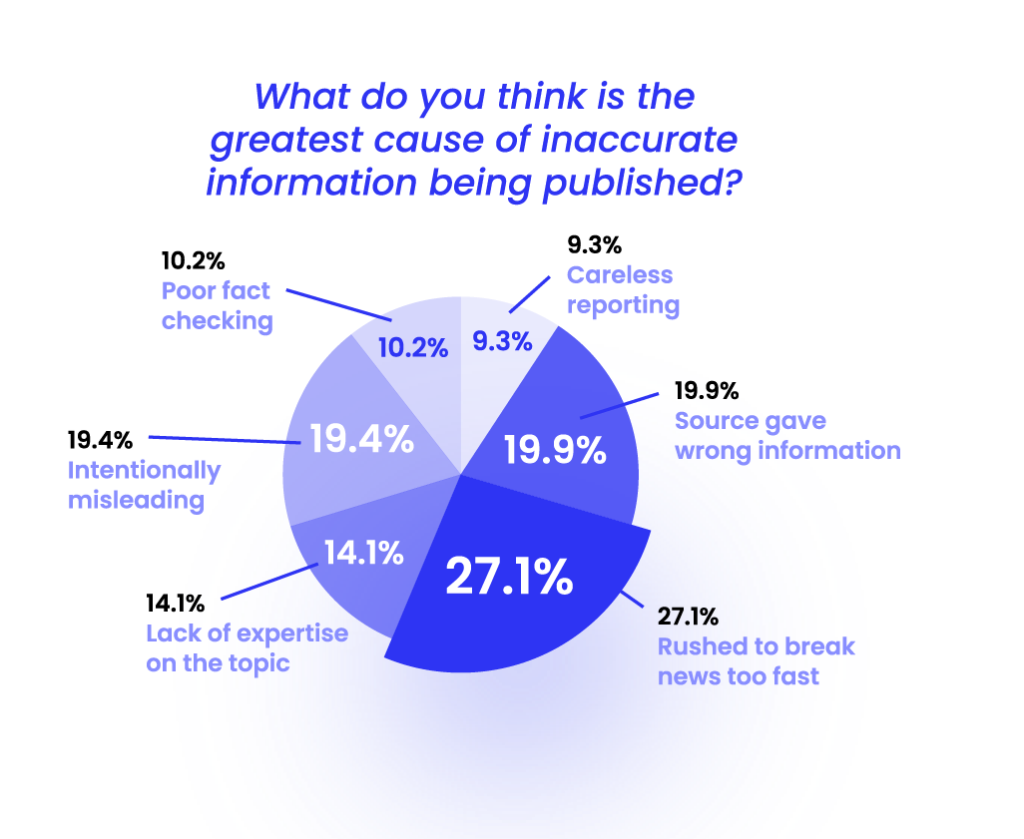
61% believe better fact-checking and a focus on accuracy could improve their trust of news organizations
What are some things a news organization could do to improve trust? We asked our respondents to choose all that apply:
- Do a better job fact-checking before publishing (32.2%)
- Focus more on accuracy and less on speed (28.6%)
- Be more transparent about who owns them and where their money comes from (13.6%)
- Fire journalists who consistently publish inaccurate information (10.1%)
- Clarify whether an article is opinion or news (6.2%)
- Admit when they make a mistake (5.3%)
- Share more information about their editorial process (4%)
These responses echo the previous question: Respondents want better journalistic practices, more accountability to those practices, more transparency, and less focus on breaking news ahead of getting it right.
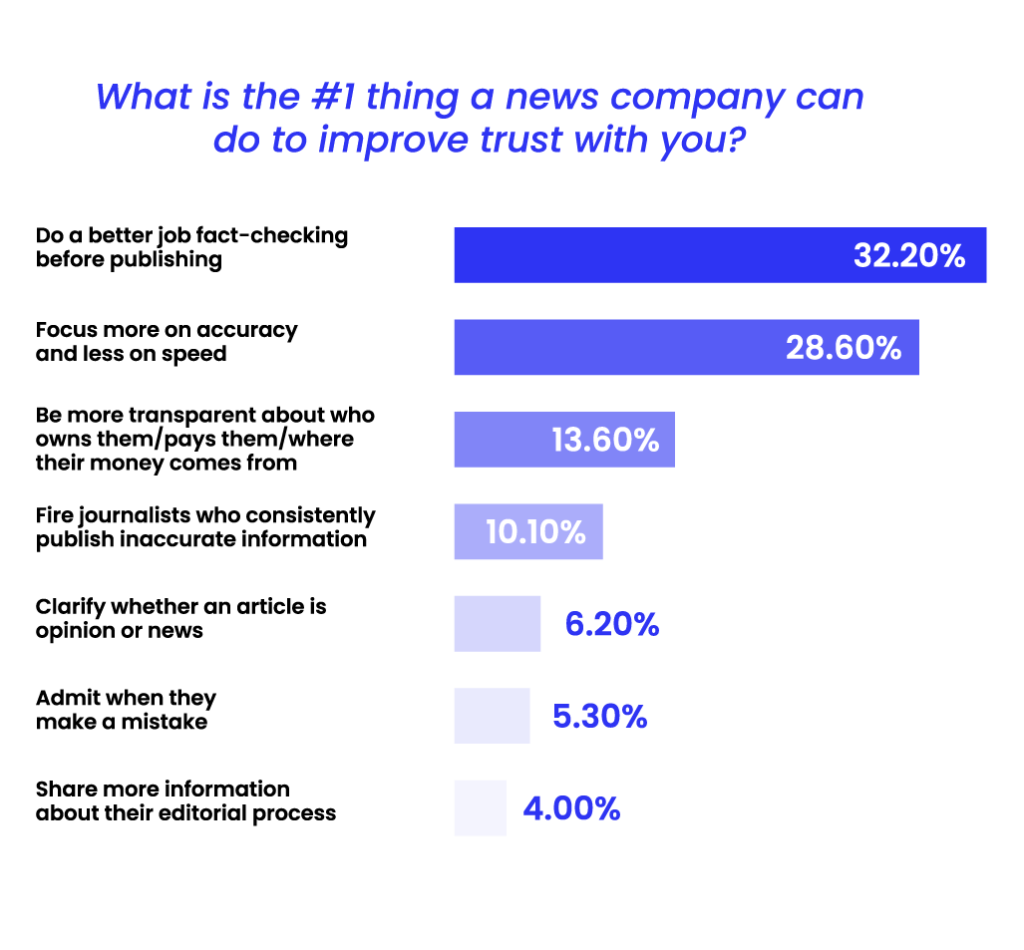
Respondents want mistakes corrected, and public admittance of wrong
In terms of being held accountable for inaccurate information, what should an organization do if they publish something they later learn is inaccurate? Our respondents were split on varying levels of transparency about the mistake:
Update the inaccurate information in the article (29.4%): The majority simply want a fix in the article without the need to bring attention to it.
Add a note about the correction somewhere on the article (28.5%): Some want the organization to correct the information in the article, and make a note about the correction.
Post on social media they made a mistake and have fixed it (26.8%): Some want the organization to make the correction and publicly admit to the mistake on social media.
Have a dedicated section on their website to list inaccuracies with detailed explanations (14.6%): Others wanted a section on the website that shows an ongoing list of mistakes, so that the public can keep track of past wrongs.
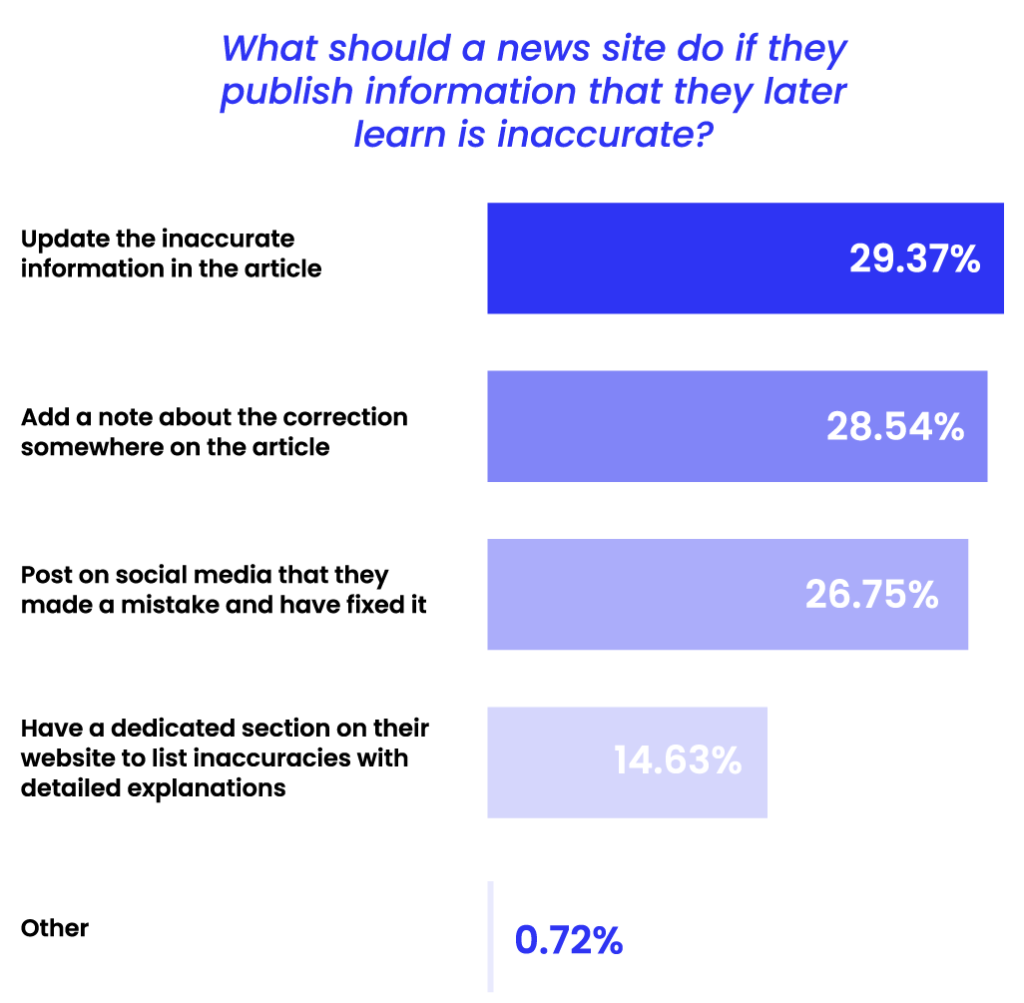
66% want journalists to be held accountable for frequent misinformation
Finally, in elaborating on one of the selections above, we wanted to know if our respondents thought that journalists who repeatedly publish inaccurate information should be fired. 66.2% said yes, while 33.8% said no.
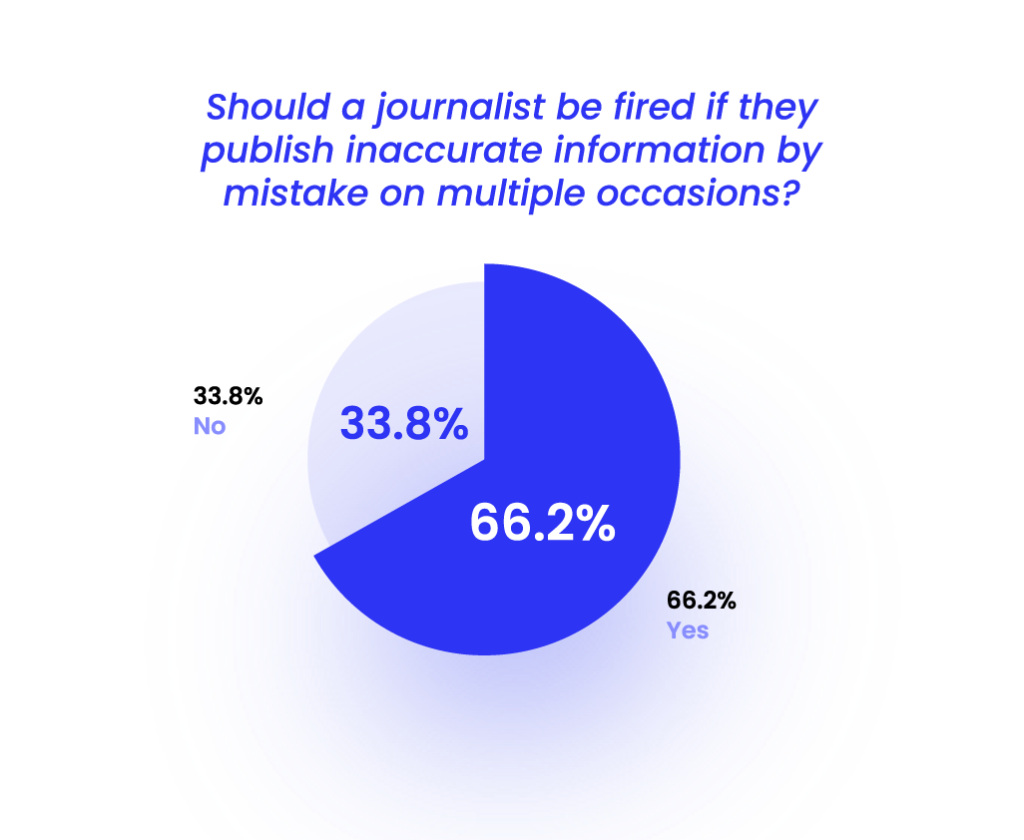
Section Summary
How are organizations failing at providing accurate, trustworthy news to their readers? Bad journalistic practices and rushing to break news. Our respondents believe that journalists and news organizations just aren’t doing their due diligence of checking facts, verifying sources, and making sure their articles are airtight before going to print.
The good news for news sites is that these issues are fixable and trust can be regained: Respondents want better fact-checking, more transparency into their practices, and accountability when they do publish something inaccurate. Better journalistic practices will lead to increased trust, which will lead to higher readership and loyalty.
Conclusion
The general public’s relationship with news organization is complicated — or is it?
People expect one thing from their news sites: Accurate, fact-checked, and objective information. They also want transparency into journalistic practices, and public accountability for when a news site gets something wrong. If news sites intentionally or unintentionally fail to do this, then they’ll see both readership and revenue head out the door.
In many ways, trust is a business strategy that news organizations can’t afford to ignore — because, as we’ve seen here, it could only take one article to lose a reader forever.